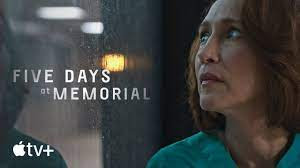One thing you learn very quickly in post-Katrina New Orleans is don’t mention Katrina.
If you do, you aren’t met with hostility, nor are you shunned. You will just receive a look of pain and a thousand-yard stare: a moment of unmitigated sadness, quickly followed by “let’s move along, shall we?”
Most screen work on the drowning of New Orleans has been feature-length documentaries, documentary series or television series. The only feature film I know of isHours(Eric Heisserer, 2014) and the titan of the docos is Spike Lee’s When the Levees Broke: a Requiem in Four Acts(2006): 4 hours and 15 minutes of searing condemnation of how New Orleans was effectively regarded as a disposable city.
In Spike Lee’s film, seeing the levees look like sheets of corrugated iron stuck into mounds of dirt is as sobering as the fatuously incompetent remarks from those officially in charge, the Army Corps of Engineers. This is how they maintained the levees to stop large areas of below-sea-level New Orleans from being devastated by catastrophe?
Treme (Eric Ellis Overmyer, David Simon, 2010-2013) has been the stand-out television series dramatization, a celebration of all that makes that city the most beguiling in the USA and one of the most unique cities in the world. It’s a heartfelt love song; and the greatest compliment I’ve ever heard for Treme came from a seasoned music-and-film writer who defiantly stopped watching after the first season “because David Simon killed off the best character”.
And so, to the latest television series Five Days at Memorial, an eight-part dramatization of Sheri Fink’s account of life in the Memorial Hospital after Katrina. It’s five days of despair before staff and patients could be evacuated and as the final boat and helicopter departs, they leave behind 45 corpses in the hospital’s chapel.
In the first few episodes, hospital staff are interrogated by unseen inquisitors: how did this happen? What caused the high body count? Why was it far higher than comparable health facilities that faced comparable issues under the rampant floods coming from Lake Pontchartrain?
There’s a lot of hedging, a lot of obfuscation, but essentially these poor souls can’t find the words to explain how the power failed, the hospital flooded, the heat became unbearable, the toilets blocked and the medical care became rudimentary and, in the end, undeliverable. When evacuation help finally arrived on day five, not everyone could be saved.
Decisions had to be made. The able-bodied went first. The most seriously bedridden and the do-not-resuscitates were left to last. Dr. Anna Pou (Vera Farmiga, never better) leads the team to make these abandoned patients “more comfortable”.
The final shot of episode 5 shows the face of a patient turning towards some footsteps coming toward him – it’s one of the subtlest, most horrifying moments I’ve seen on film or television.
As episode 6 opens, we are introduced to the previously unseen inquisitors as they start investigating and interviewing the survivors. Incomprehension at how any health professional could have agreed to these drastic measures is met with self-laceration but also with feisty combativeness – we were left to die, how dare you come and question our decisions.
A very hard watch, but one of best series of the year.

No comments:
Post a Comment
Note: only a member of this blog may post a comment.